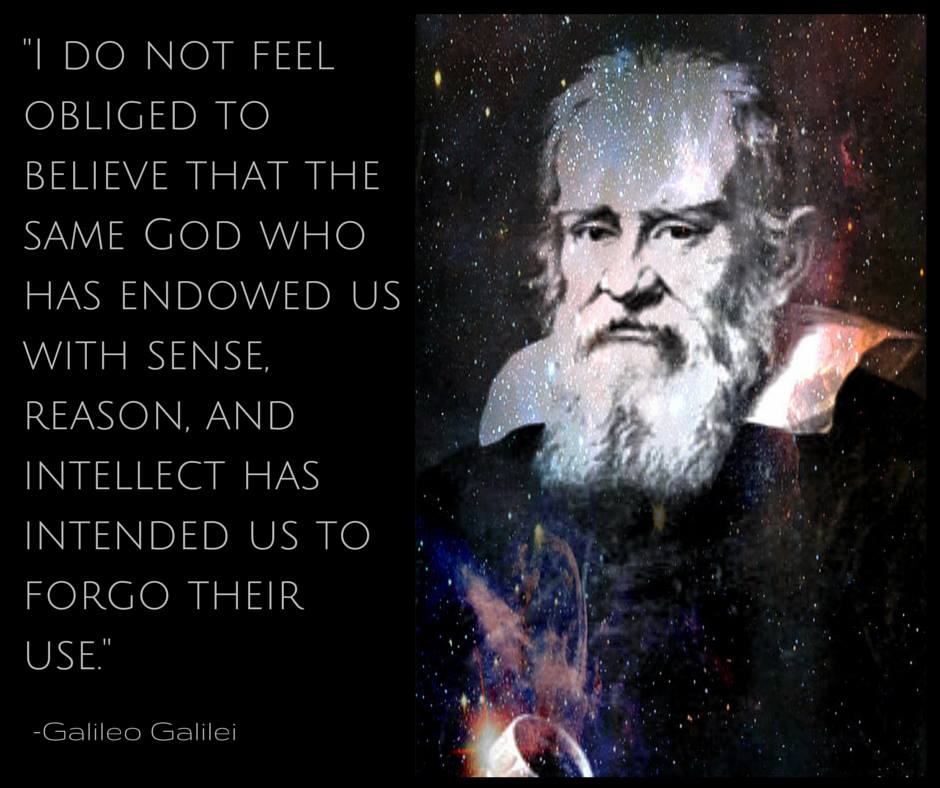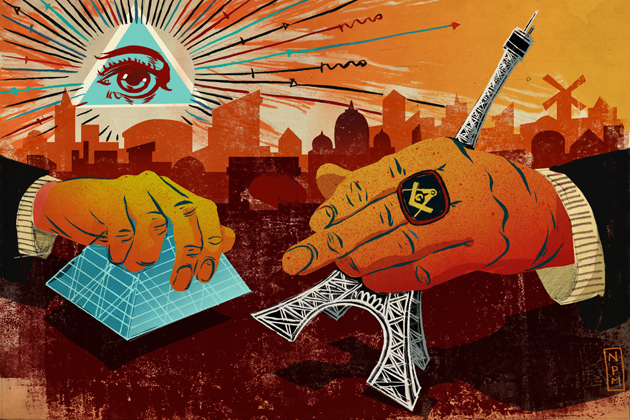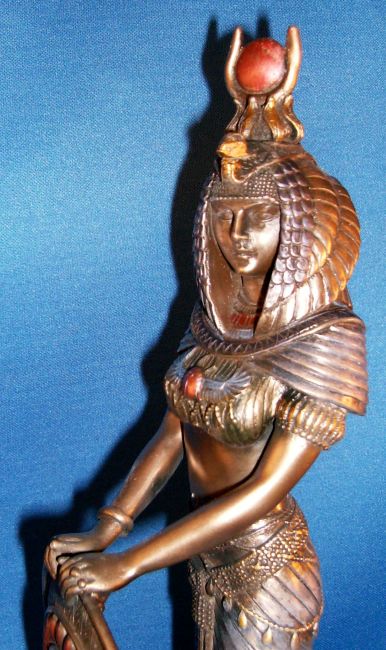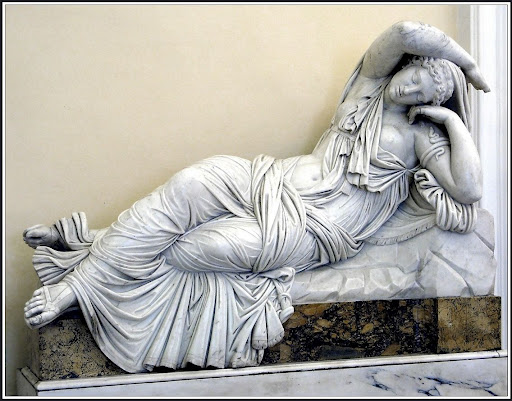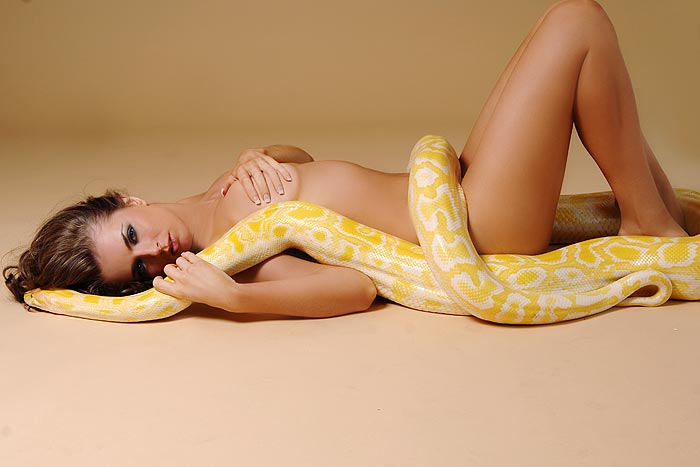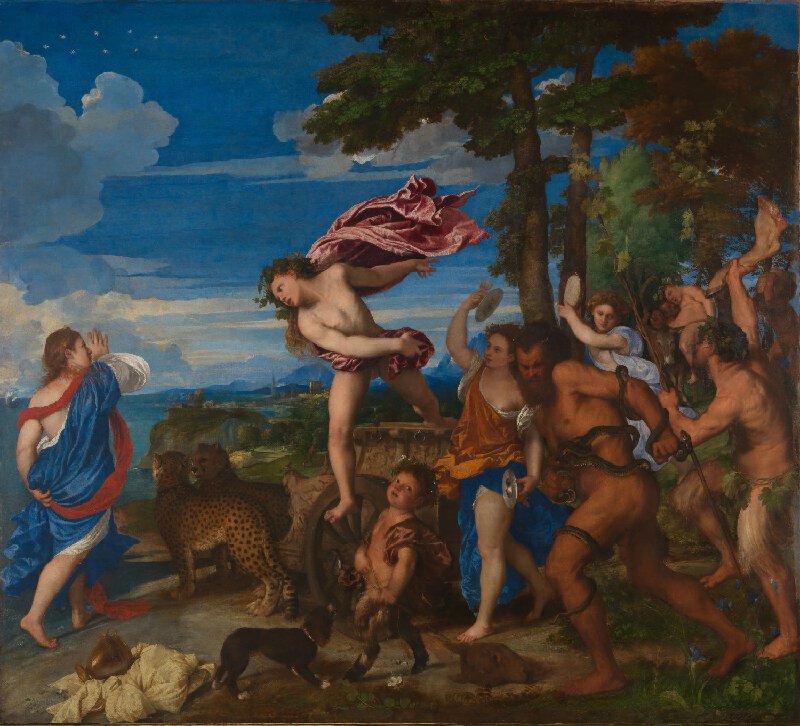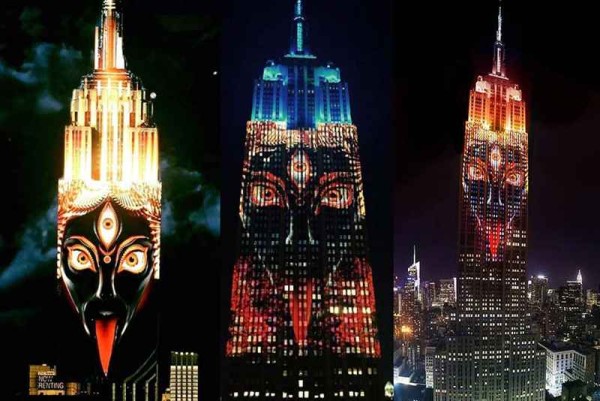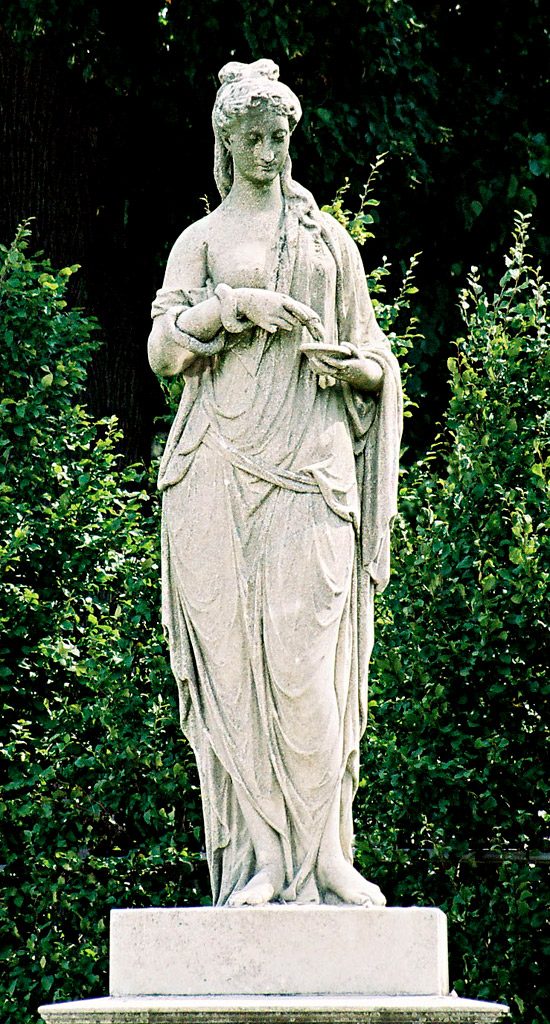(Evolution of the Dragon by G. Elliot Smith -“THE SERPENT AND THE LIONESS”) – When the development of the story of the Destruction of Mankind necessitated the 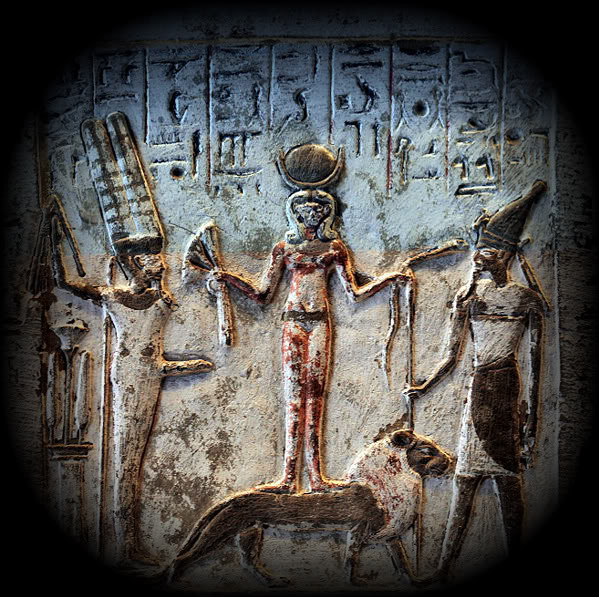 finding of a human sacrifice and drove the Great Mother to homicide, this side of her character was symbolized by identifying her with a man-slaying lion and the venomous uræus-serpent.
finding of a human sacrifice and drove the Great Mother to homicide, this side of her character was symbolized by identifying her with a man-slaying lion and the venomous uræus-serpent.
She had previously been represented by such beneficent food-providing and life-sustaining creatures as the cow, the sow, and the gazelle (antelope or deer): but when she developed into a malevolent creature and became the destroyer of mankind it was appropriate that she should assume the form of such man-destroyers as the lion and the cobra.
Once the reason for such identifications grew dim, the uræus-form of the Great Mother became her symbol in either of her aspects, good or bad, although the legend of her poison-spitting, man-destroying powers persisted. 1 The identification of the destroying-goddess with the moon, “the Eye of the Sun-god,” prepared the way for the rationalization of her character as a uræus-serpent spitting venom and the sun’s Eye spitting fire at the Sun-god’s enemies. Such was the goddess of Buto in Lower Egypt, whose uræus-symbol was worn on the king’s forehead, and was misinterpreted by the Greeks as not merely a symbolic “eye,” but an actual median eye upon the king’s or the god’s forehead.
It is not without special significance that in the ancient legend (see Sethe, op. cit.) the lioness-goddess Tefnut was reputed to have come from Elephantine (or at any rate the region of Sehêl and Biga, which has the same significance), which serves to demonstrate her connexion with the story of the Destruction of Mankind and to corroborate the inference as to its remote antiquity. She was identified with Hathor, Sekhet, Bast, and other goddesses.
But the uræus was not merely the goddess who destroyed the king’s enemies and the emblem of his kingship: in course of time the Cobra became identified with the ruler himself and the dead king, who was the god Osiris. When this happened the snake acquired the god’s reputation of being the controller of water.
The fashionable speculation of modern scholars that the movements of the snake naturally suggest rippling water 1 and provide “the obvious reason” which led many people quite independently the one of the other to associate the snake with water, is thus shown to have no foundation in fact.
One would have imagined that, if any natural association between snakes and water was the reason for this association, a water-snake would have been chosen to express the symbolism; or, if it was the mere rippling motion of the reptile, that all snakes or any snake would have been drawn into the analogy. But primarily only one kind of snake, a cobra, was selected; 2 and it is not a water snake, and cannot live in or under water. It was selected because it was venomous and the appropriate symbol of man-slaying.
The circumstances which led to the identification of this particular serpent with water were the result of a process of legend-making of so arbitrary and eccentric a nature as to make it impossible seriously to pretend that so tortuous a ratiocination should have been exactly followed to the same unexpected destination also in Crete and Western Europe, in Babylonia and India, in Eastern Asia, and in America, without prompting the one of the other. No serious investigator who is capable of estimating the value of evidence can honestly deny that the belief in the serpent’s control over water was diffused abroad from one centre where a concatenation of peculiar circumstances and beliefs led to the identification of the ruler with the cobra and the control of water.
We are surely on safe ground in assuming the improbability of such a wholly fortuitous set of events happening a second time and producing the same result elsewhere. Thus when we find in India the Nâga, rajas identified with the cobra, and credited with the ability to control the waters, we can confidently assume that in some way the influence of these early Egyptian events made itself felt in India. As we compare the details of the Nâga worship in India 1 with early Egyptian beliefs, all doubt as to their common origin disappears.
The Nâga rulers were closely associated with springs, streams, and lakes. “To this day the rulers of the Hindu Kush states, Hunza and Nagar, though now Mohammedans, are believed, by their subjects, to be able to command the elements.”
Oldham adds: “This power is still ascribed to the serpent-gods of the sun-worshipping countries of China, Manchuria, and Korea, and was so, until the introduction of Christianity, in Mexico and Peru”. This is put forward in support of his argument that the Nâga kings’ “supposed ability to control the elements, and especially the waters,” arose “from their connexion with the sun”. But this is not so. 2 The belief in the Egyptian king’s power over water was certainly older than sun-worship, which did not begin until Osirian beliefs and the personification of the moon as the Great Mother brought the sky-deities and the control of water into correlation the one with the other. The association of the sun and the serpent in the royal insignia was a later development.
The early Egyptian goddess was identified with the uræus-serpent in that vitally important nodal point of primitive civilization, Buto, in Lower Egypt. The earliest deity in Crete and the Eastern Mediterranean seems to have been a goddess who was also closely associated with the serpent. According to Langdon “the ophidian nature of the earliest Sumerian mother-goddess Innini is unmistakable. … She carries the caduceus in her hand, two serpents twining about a staff.” 1
The earliest Indian deities also were goddesses, and the first rulers of whom any record has been preserved were regarded as divine cobras, to whom was attributed the power of controlling water. These Nâgas, whether kings or queens, gods or goddesses, were the prototypes of the Eastern Asiatic dragon, whose origin is discussed in Chapter II.
In Japan the earliest sun-deity was a goddess who was identified with a snake. Elsewhere in this volume (Chapter II) I have referred to the completeness of the transference to America of these Old World ideas of the serpent. Right on the route taken by the main stream of cultural diffusion across the Pacific we still find in their fully-developed form the old beliefs concerning the good Mother Serpent of the ancient civilizations (C. E. Fox and F. H. Drew, op. cit. supra, p. 139). She could be re-incarnated as a coconut: she controlled crops; she was associated with the coming of death into the world, with the introduction of agriculture and the discovery of fire. Like her predecessors in the West she was also a Mother Pot or Basket that never emptied.
All the hiona or figona (i.e. spirits) of San Cristoval have a serpent incarnation from Agunua the creator, worshipped by every one, to Oharimae and others, only known to particular persons. Other spirits, called ataro, might be incarnate in almost any animal. Agunua, who took the form of a serpent, was good, not evil (p. 134). Very many pools, rocks, water-falls, or large trees were thought to be the abode of figona. These serpent spirits could take the form of a stone, or retire within a stone, and sacred stones seem to be connected with figona rather than with ataro (p. 135). Almost all the local figona are represented as female snakes, but Agunua is a male snake (p. 137).
As the real significance of the snake’s symbolism originated from its identification with the Great Mother in her destructive aspect, it is not surprising that the snake is the most primitive form of the evil dragon. The Babylonian Tiamat was originally represented as a huge serpent, 1 and throughout the world the serpent is pre-eminently a symbol of the evil dragon and the powers of evil.
The serpent that tempted Eve was the homologue both of the mother of mankind herself and also of the tree of paradise. It was the representative of the dragon-protector of pearls and of other kinds of treasure: it was also the goddess who animated the sacred tree as well as the protector who attacked all who approached it. It was the evil dragon that tempted Eve to eat of the forbidden fruit which brought her mortality.
The identification of the Great Mother with the lioness (and the secondary association of her husband and son with the lion) was responsible for a widespread relationship of these creatures with the gods and goddesses in Egypt and the Mediterranean, in Western Asia, in Babylonia and India, in Eastern Asia [tiger] and America [ocelot, and forms borrowed from the conventionalized lions and tigers of the Old World].
The account of the Great Mother’s attributes and associations throws into clear relief certain aspects of the evolution of the dragon which were left in a somewhat nebulous state in Chapter II. The earliest form assumed by the power of evil was the serpent or the lion, because these death-dealing creatures were adopted as symbols of the Great Mother in her rôle as the Destroyer of Mankind. When Horus was differentiated from the Great Mother and became her locum tenens, his falcon (or eagle) was blended with Hathor’s lioness to make the composite monster which is represented on Elamite and Babylonian monuments (see p. 79). But when the rôle of water as the instrument of destruction became prominent, Ea’s antelope and fish were blended to make a monster, usually known as the “goat-fish,” which in India and elsewhere assumed a great variety of forms. Some of the varieties of makara were sufficiently like a crocodile to be confused or identified with this representative of the followers of Set.
The real dragon was created when ail three larval types—serpent, eagle-lion, and antelope-fish—were blended to form a monster with bird’s feet and wings, a lion’s forelimbs and head, the fish’s scales, the antelope’s horns, and a more or less serpentine form of trunk and tail, and sometimes also of head. Repeated substitution of parts of other animals, such as the spiral horn of Amen’s ram, a deer’s antlers, and the elephant’s head, led to endless variation in the dragon’s traits.
The essential unity of the motives and incidents of the myths of all peoples and of every age is a token, not of independent origin or the result of “the similarity of the working of the human mind,” but of their derivation from the same ultimate source.
The question naturally arises: what is a myth? The dragon-myth of the West is the religion of China. The literature of every religion is saturated with the influence of the myth. In what respect does religion differ from myth? In Chapter I, I attempted to explain how originally science and religion were not differentiated. Both were the outcome of man’s attempt to peer into the meaning of natural phenomena, and to extract from such knowledge practical measures for circumventing fate. His ever-insistent aim was to combat danger to life.
Religion was differentiated from science when the measures for controlling fate became invested with the assurance of supernatural help, for which the growth of a knowledge of natural phenomena made it impossible for the mere scientist to be the sponsor. It became a question of faith rather than knowledge; and man’s instinctive struggle against the risk of extinction impelled him to cling to this larger hope of salvation, and to embellish it with an ethical and moral significance which at first was lacking in the eternal search for the elixir of life.
If religion can be regarded as archaic science enriched with the belief in supernatural control, the myth can be regarded as effete religion which has been superseded by the growth of a loftier ethical purpose. The myth is to religion what alchemy is to chemistry or astrology is to astronomy. Like these sciences, religion retains much of the material of the cruder phase of thought that is displayed in myth, alchemy, and astrology, but it has been refined and elaborated. The dross has been to a large extent eliminated, and the pure metal has been moulded into a more beautiful and attractive form. In searching for the elixir of life, the makers of religion have discovered the philosopher’s stone, and with its aid have transmuted the base materials of myth into the gold of religion.
If we seek for the deep motives which have prompted men in all ages so persistently to search for the elixir of life, for some means of averting the dangers to which their existence is exposed, it will be found in the instinct of self-preservation, which is the fundamental factor in the behaviour of all living beings, the means of preservation of the life which is their distinctive attribute and the very essence of their being.
The dragon was originally a concrete expression of the divine powers of life-giving; but with the development of a higher conception of religious ideals it became relegated to a baser rôle, and eventually became the symbol of the powers of evil.

Moe is the founder of GnosticWarrior.com. He is a father, husband, author, martial arts black belt, and an expert in Gnosticism, the occult, and esotericism.

